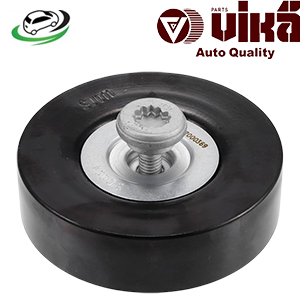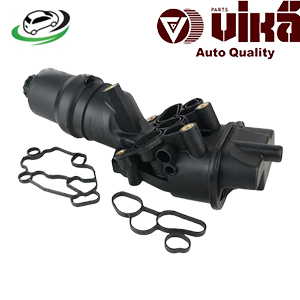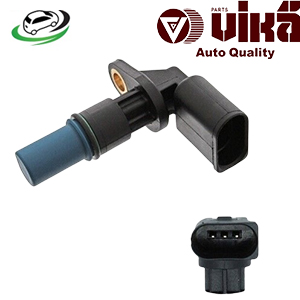-14%
Get AUDI A3 (8L1)/ A3 (8P1)/ A4 B6 (8E2)/ A4 B7 (8EC) / VW Bora I (1J2)/ Golf V (1K1)/ Jetta III (1K2)/ Passat B6 (3C2) Camshaft Position Sensor 06B905163A
The camshaft position sensor is a critical component in modern vehicles, providing essential data to the engine control unit (ECU) to ensure efficient engine operation. By monitoring the position and rotational speed of the camshaft, this sensor helps synchronize engine functions like fuel injection and ignition timing. This ensures that the engine runs smoothly, efficiently, and with minimal emissions. In this comprehensive guide, we will explore the camshaft position sensor’s function, importance, benefits, common problems, and maintenance tips.
1. Functions of the Camshaft Position Sensor
The camshaft position sensor is responsible for detecting the exact position of the camshaft as it rotates. This data is crucial for the proper timing of various engine operations, particularly for fuel injection and ignition. Here’s a closer look at the specific functions of the sensor:
- Detecting Camshaft Position: The sensor monitors the position of the camshaft relative to the crankshaft. The camshaft controls the opening and closing of the intake and exhaust valves, and the sensor provides the ECU with information on the camshaft’s position to optimize the timing of these actions.
- Ensuring Precise Fuel Injection: In engines with electronic fuel injection systems, the camshaft position sensor helps determine when and how much fuel to inject into the combustion chamber. By knowing the exact position of the camshaft, the ECU can synchronize fuel injection with the opening of the intake valves, improving fuel efficiency and performance.
- Coordinating Ignition Timing: The camshaft position sensor also plays a vital role in controlling the ignition timing. It ensures that the spark plugs fire at the right moment, which is essential for the proper combustion of the air-fuel mixture. If the timing is off, it can lead to poor engine performance, misfires, or even engine damage.
- Supporting Variable Valve Timing (VVT): In modern engines equipped with VVT systems, the camshaft position sensor helps regulate the timing of the valve operation based on engine speed and load. This allows for better performance and fuel efficiency by optimizing airflow into the engine at different speeds.
2. Benefits of a Functioning Camshaft Position Sensor
The camshaft position sensor plays a crucial role in ensuring that the engine runs smoothly and efficiently. A properly functioning sensor offers the following benefits:
- Improved Engine Performance: By providing accurate data to the ECU, the camshaft position sensor ensures that the fuel injection and ignition systems operate with precision. This leads to smoother acceleration, better throttle response, and overall improved engine performance.
- Enhanced Fuel Efficiency: When the camshaft position sensor is working correctly, the engine can optimize fuel consumption by injecting the right amount of fuel at the right time. This results in more efficient fuel use, which can lower fuel costs over time.
- Reduced Emissions: Proper timing of the combustion process helps reduce harmful emissions from the exhaust system. By ensuring that the air-fuel mixture is combusted efficiently, the camshaft position sensor contributes to cleaner engine operation and reduced environmental impact.
- Prevention of Engine Misfires: Engine misfires occur when the air-fuel mixture in the combustion chamber doesn’t ignite properly. A faulty camshaft position sensor can lead to incorrect timing, resulting in misfires. A functioning sensor ensures that the ignition timing is accurate, preventing these misfires and avoiding potential damage to the engine.
- Improved Variable Valve Timing: For engines with VVT systems, the camshaft position sensor ensures optimal performance by adjusting the valve timing according to driving conditions. This improves power delivery, fuel economy, and overall engine responsiveness.
3. Common Problems with Camshaft Position Sensors
Like any other automotive component, camshaft position sensors are subject to wear and tear over time. Some common issues with camshaft position sensors include:
- Sensor Failure Due to Heat: The camshaft position sensor is often located near the engine, where it is exposed to high temperatures. Over time, constant exposure to heat can cause the sensor to degrade or fail. This can lead to erratic engine performance or even stalling.
- Electrical Issues: Since the sensor is an electronic component, it can be affected by issues such as corroded or loose electrical connections, damaged wiring, or a short circuit. These problems can disrupt the sensor’s ability to send accurate data to the ECU, leading to poor engine performance.
- Magnetic Interference: Many camshaft position sensors rely on magnetic fields to detect the camshaft’s position. If there is interference from nearby magnetic sources or if the sensor itself becomes demagnetized, it may stop working correctly.
- Contamination: Oil leaks, dirt, or debris can contaminate the camshaft position sensor, affecting its accuracy. Contamination may cause the sensor to send incorrect signals to the ECU, leading to issues such as poor fuel economy, rough idling, or engine stalling.
4. Symptoms of a Faulty Camshaft Position Sensor
When the camshaft position sensor starts to fail, it can lead to a variety of symptoms that affect the engine’s performance. Some of the most common signs include:
- Check Engine Light: One of the first indications of a faulty camshaft position sensor is the illumination of the Check Engine Light on the dashboard. The ECU will detect an issue with the sensor and trigger the warning light.
- Rough Idling or Stalling: A failing camshaft position sensor can cause the engine to idle roughly or even stall, particularly when the vehicle is at a stop. This occurs because the ECU cannot accurately control the fuel injection or ignition timing.
- Poor Acceleration: If the camshaft position sensor is not working correctly, the engine may struggle to deliver power smoothly. This can result in sluggish acceleration or hesitation when pressing the gas pedal.
- Engine Misfires: Inaccurate ignition timing due to a faulty camshaft position sensor can cause misfires in one or more cylinders. This leads to reduced engine performance, poor fuel efficiency, and potential damage to the catalytic converter.
- Difficulty Starting: In some cases, a failing camshaft position sensor can make it difficult for the engine to start. This is because the ECU relies on the sensor to determine the proper timing for the ignition and fuel systems.
5. Maintenance and Replacement of Camshaft Position Sensors
Proper maintenance and timely replacement of the camshaft position sensor can help prevent engine performance issues and ensure the longevity of the engine. Here are some maintenance tips:
- Regular Inspections: During routine vehicle maintenance, such as oil changes or tune-ups, have the camshaft position sensor inspected for signs of wear or damage. This can help identify potential issues before they become serious.
- Check Electrical Connections: Since the camshaft position sensor is an electronic component, it’s essential to check the electrical connections periodically. Ensure that the wiring is intact, free of corrosion, and properly connected to avoid signal disruptions.
- Clean the Sensor: If the sensor becomes contaminated with oil, dirt, or debris, it may send inaccurate signals to the ECU. Cleaning the sensor and the surrounding area can help ensure that it operates correctly.
- Replace the Sensor When Necessary: Camshaft position sensors typically last for many years, but like any part, they can eventually fail. If you notice symptoms of a faulty sensor, such as rough idling or poor acceleration, have the sensor replaced promptly to prevent further engine issues.
- Use Quality Replacement Parts: When replacing a camshaft position sensor, it’s crucial to use high-quality replacement parts. OEM (original equipment manufacturer) sensors are recommended to ensure compatibility and reliability.
6. Conclusion
The camshaft position sensor plays a crucial role in modern engine management systems. By providing the ECU with accurate data on the camshaft’s position and speed, this sensor ensures that fuel injection and ignition timing are precisely coordinated for optimal engine performance. A functioning camshaft position sensor helps improve fuel efficiency, reduce emissions, and prevent engine misfires. Regular inspection, proper maintenance, and timely replacement of the sensor can help keep the engine running smoothly and prevent costly repairs.
Follow us on Facebook for more parts.




Reviews
Clear filtersThere are no reviews yet.